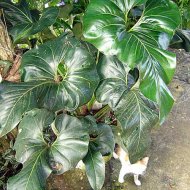Care of the plant Philodendron giganteum or Giant Elephant Ear |
|
The genus Philodendron, family Araceae, includes about 700 species of tropical plants native to Central and South America. Some species are: Philodendron giganteum, Philodendron selloum, Philodendron scandens, Philodendron speciosum, Philodendron Birkin, Philodendron verrucosum, Philodendron giganteum, Philodendron andreanum, Philodendron hastatum, Philodendron sanguineum, Philodendron goeldii. Common names: Giant Philo, Giant Elephant Ear, Giant philodendron. This species is native to the Caribbean and South America. They are fast-growing climbing tropical plants that exceed 3 meters (9.84 feet) in height. The large, attractive, glossy green leaves are up to 1 meter (3.28 feet) in length. The flowers have no decorative interest. These plants are toxic if swallowed. They are used as indoor and greenhouse plants. In tropical regions they are used as isolated specimens and in borders and borders. The Philodendron giganteum prefers a semi-shade exposure receiving direct sun early in the morning or late in the afternoon. Do not expose it to temperatures below 13 ºC (55.4 ºF). The soil can be a commercial cactus substrate to which peat, perlite and coconut bark will be added. Transplant adult plants every 4 years in early spring or mid-fall. Water once a week with lime-free water in spring, summer and autumn. In winter water 2 times a month. The environmental humidity must be medium-high, for which it is convenient to spray the leaves periodically with water without lime and place a tray with wet pebbles under the pot. Fertilize with compost at the end of winter and once a month with mineral fertilizer for indoor plants in spring and summer. They do not need pruning. They are quite resistant to the usual pests and diseases but sensitive to excess watering and drought. They are propagated by cuttings but it is not a simple process since adult specimens are needed and they do not always take root correctly. |
Images of the plant Philodendron giganteum or Giant Elephant Ear |
Find plants
Philodendron giganteum or Giant Elephant Ear | Care and Growing
© 2024 FavThemes
